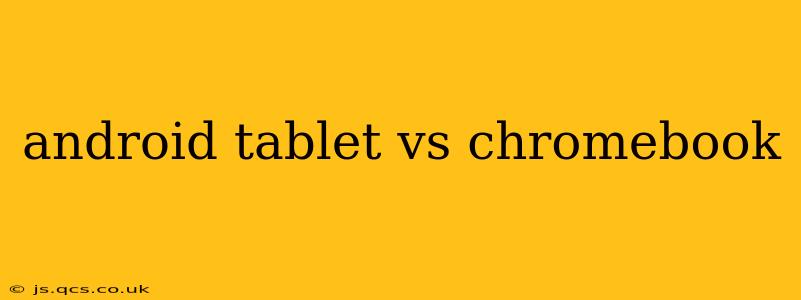Choosing between an Android tablet and a Chromebook can feel overwhelming. Both offer portable computing experiences, but cater to different needs and preferences. This comprehensive guide dives deep into the strengths and weaknesses of each, helping you decide which device best suits your lifestyle and budget. We'll explore key differences, address frequently asked questions, and ultimately empower you to make an informed decision.
What are the Key Differences Between Android Tablets and Chromebooks?
The core difference lies in their operating systems and functionalities. Android tablets run on Google's Android OS, primarily designed for touch-based interactions and mobile apps. Chromebooks, on the other hand, utilize Chrome OS, a streamlined operating system built around the Chrome browser and Google's cloud services. This fundamental distinction shapes their capabilities and target users.
Android tablets excel in media consumption, casual gaming, and specific productivity tasks aided by stylus support. Chromebooks, with their keyboard and trackpad, shine in web browsing, document creation (using Google Docs, Sheets, Slides), and light productivity tasks.
What are the Advantages of an Android Tablet?
- Touchscreen Experience: Android tablets prioritize touch interaction, making them intuitive for browsing, media consumption, and certain creative tasks.
- App Ecosystem: Access to the vast Google Play Store offers a wide selection of apps, games, and entertainment options.
- Portability: Generally lighter and more compact than Chromebooks, making them incredibly portable.
- Stylus Support (some models): Many Android tablets offer stylus support, enhancing note-taking, drawing, and creative capabilities.
What are the Advantages of a Chromebook?
- Keyboard and Trackpad: The integrated keyboard and trackpad offer a more traditional computing experience, ideal for typing documents and performing tasks requiring precision input.
- Chrome OS Simplicity: Chrome OS is known for its simplicity and ease of use. It's lightweight and boots quickly.
- Cloud Integration: Seamless integration with Google services like Drive, Gmail, and Docs makes cloud-based workflows incredibly efficient.
- Affordability: Chromebooks generally offer a lower price point than comparable Android tablets or laptops.
Which is Better for Students?
The best choice for students depends on their specific needs. Chromebooks excel for students who heavily rely on Google Workspace for assignments and research. The keyboard and trackpad are beneficial for essay writing and projects requiring detailed typing. Android tablets might be preferable for students who need a portable device for note-taking (with stylus support) and casual learning apps.
Which is Better for Media Consumption?
Android tablets generally win in this category. Their larger, higher-resolution screens and optimized app ecosystem for streaming services and video playback offer a superior media consumption experience.
Which is Better for Gaming?
While both platforms offer games, Android tablets generally have a broader selection of mobile games and often have better touch controls optimized for gaming. Chromebooks, however, can run some games via the browser or through cloud gaming services.
Which is Better for Productivity?
For serious productivity tasks involving complex software or large files, neither Android tablets nor Chromebooks are ideal. A full-fledged laptop would be a better choice. However, for lighter productivity tasks like email, document editing (using Google Workspace), and web browsing, Chromebooks offer a more comfortable experience due to their keyboard and trackpad.
Which is Better for Offline Work?
Chromebooks can work offline with downloaded files and apps, but their functionality is severely limited compared to a laptop. Android tablets also offer some offline capabilities depending on the apps used. However, both devices are fundamentally designed for online connectivity.
Android Tablet vs. Chromebook: The Verdict
The "better" choice depends entirely on individual needs and priorities. Android tablets are ideal for media consumption, casual gaming, and touch-centric tasks. Chromebooks are excellent for web browsing, light productivity using Google services, and students who rely on Google Workspace. Consider your primary usage scenarios, budget, and desired features to make the most informed decision.
